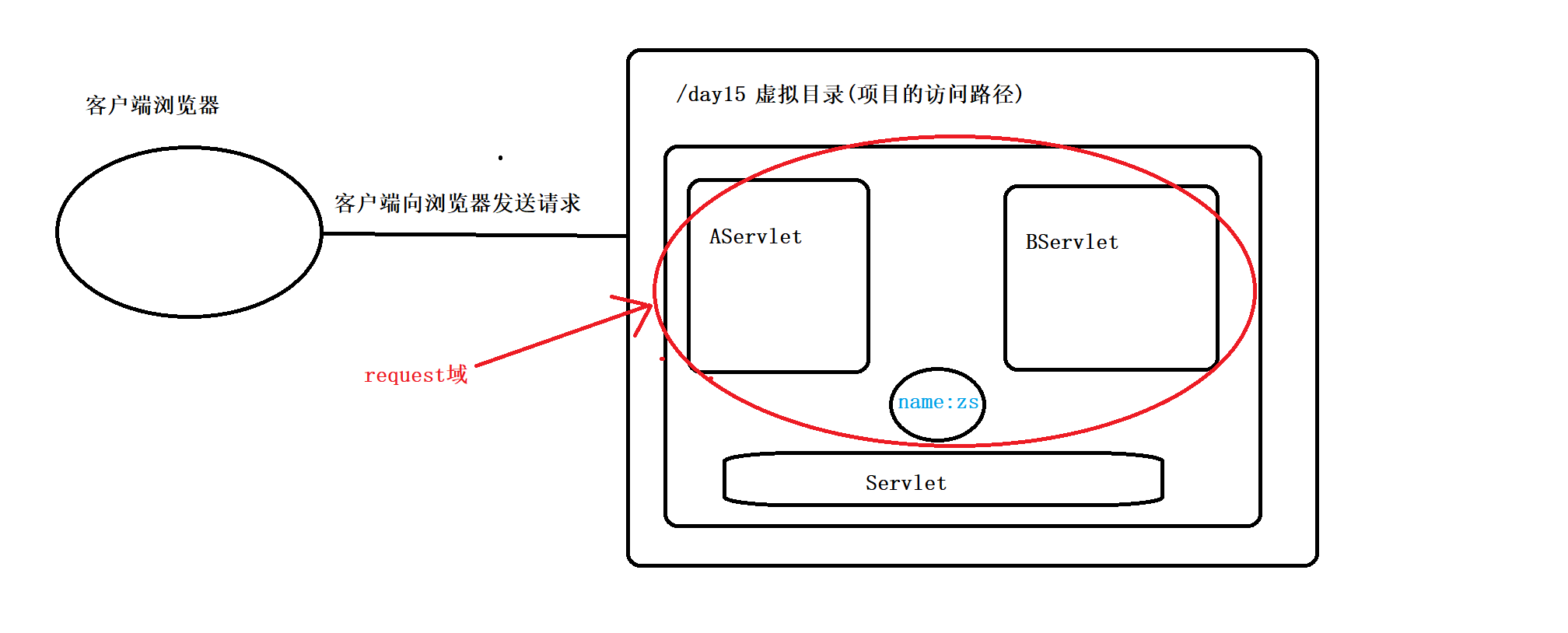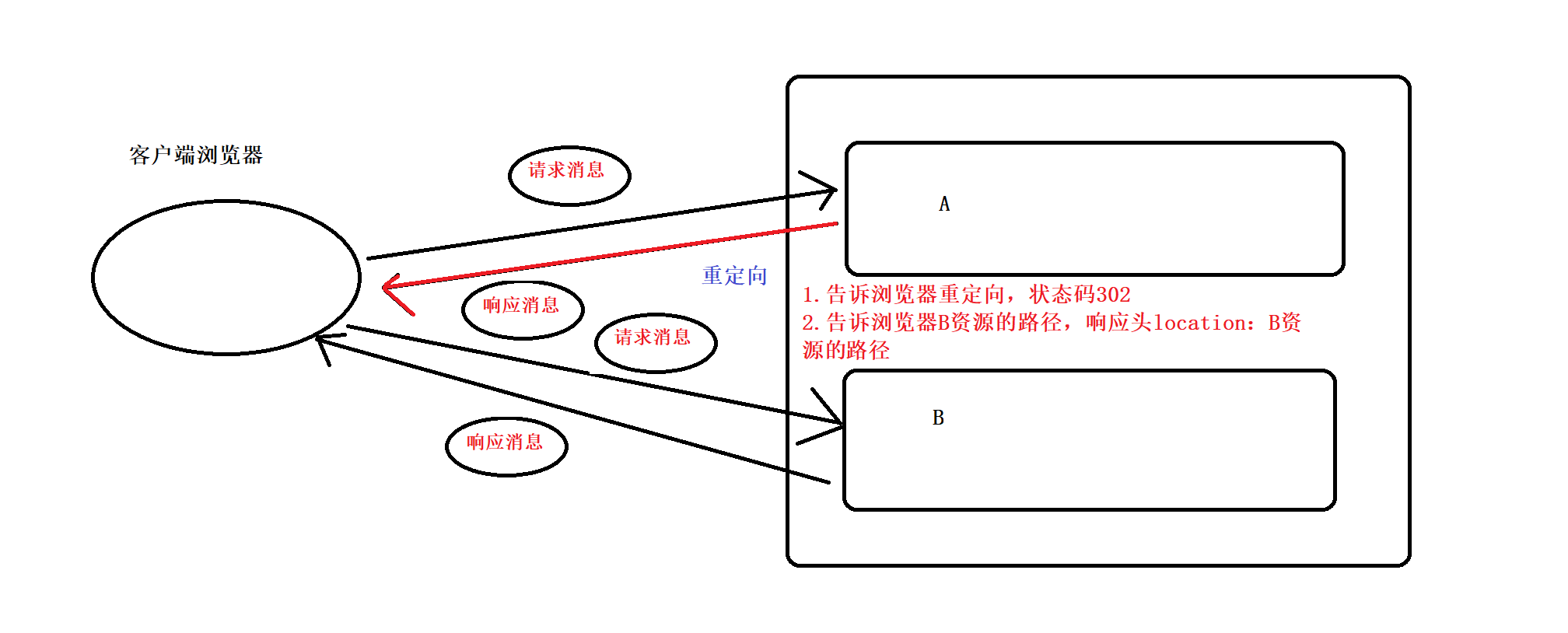功能:设置响应消息
- 设置响应行
- 格式:HTTP/1.1 200 ok
- 设置状态码:void setStatus(int sc)
- 设置响应头:void setHeader(String name, String value)
- 设置响应体:
- 使用步骤:
- 获取输出流
- 字符输出流:PrintWriter getWriter()
- 字节输出流:ServletOutputStream getOutputStream()
- 使用输出流,将数据输出到客户端浏览器
- 获取输出流
- 使用步骤:
案例
完成重定向
-
重定向:资源跳转的方式
// 动态获取虚拟目录 String contextPath = req.getContextPath(); resp.sendRedirect(contextPath+"/Servlet资源路径"); -
代码实现:
/* // 1.设置状态码为302 重定向 resp.setStatus(302); // 2.设置响应头location resp.setHeader("location", "/day15/responseDemo2"); */ // 简单的重定向方法 resp.sendRedirect("/day15/responseDemo2"); -
重定向的特点:redirect
- 地址栏路径发生变化
- 重定向可以访问其他站点(服务器)的资源
- 重定向是两次请求,不能使用request对象来共享数据
-
转发的特点:forward
- 地址栏路径不变
- 转发只能访问当前服务器下的资源
- 转发是一次请求,可以使用一个request对象来共享数据
-
forward 和 redirect 的区别(将来面试题会这样问?)
-
请求转发

- 重定向

- 路径写法(重要):
路径分类
- 相对路径:通过相对路径不可以确定唯一资源
- 如:./index.html
- 不以 / 开头,以 . 开头路径
<!-- 不写,默认是以./开头 -->
<a href="./responseDemo2">
<a href="../responseDemo2">
* 规则:找到当前资源和目标资源之间相对位置关系
* `./`:当前目录
* `../`:后退一级目录
- 绝对路径:通过绝对路径可以确定唯一资源
- 如:http://localhost/day15/responseDemo2 /day15/responseDemo2
- 以 / 开头的路径
- 规则:判断定义的路径是给谁用的?判断请求将来从哪发出
- 给客户端浏览器使用:需要加虚拟目录(项目的访问路径)
- 建议虚拟目录动态获取:request.getContextPath();
<a>,<form>,重定向...
- 给服务器使用:不需要加虚拟目录
- 转发路径
- 给客户端浏览器使用:需要加虚拟目录(项目的访问路径)
后期写 jsp页面时,推荐使用绝对路径写法,因为相对路径写起来比较麻烦
服务器输出字符数据到浏览器
-
步骤:
- 获取字符输出流
- 输出数据
-
注意:
- 乱码问题:
- 乱码原因:编码和解码使用的字符集不同
- PrintWriter pw = response.getWriter():获取的流的默认编码是 ISO-8859-1
- 设置该流的默认编码
- 告诉浏览器响应体使用的编码
- 乱码问题:
// 简单的形式,设置编码,是在获取流之前设置
response.setContentType("text/html;charset=utf-8");
- 示例
// 获取流对象PrintWriter之前,设置流的默认编码:ISO-8859-1 设置为:GBK
// resp.setCharacterEncoding("utf-8");
// 告诉浏览器,服务器发送消息体的数据的编码,建议浏览器使用该编码解码
// resp.setHeader("content-type", "text/html;charset=utf-8");
/*
resp.setHeader() 等效于
resp.setCharacterEncodin() & resp.setHeader()两行
*/
// 简单的形式,设置编码,是在获取流之前设置
resp.setContentType("text/html;charset=utf-8");// 一行顶两行
// 1.获取字节输出流
PrintWriter pw = resp.getWriter();
// 2.输出数据
pw.write("<h1>hello response</h1>");
pw.write("你好啊 response");
服务器输出字节数据到浏览器
-
步骤:
- 获取字节输出流
- 输出数据
-
示例
resp.setContentType("text/html;charset=utf-8");
// 1.获取字节输出流
ServletOutputStream sos = resp.getOutputStream();
// 2.输出数据
sos.write("你好".getBytes("utf-8")); // getBytes()默认使用的是gbk
验证码
/**
* 生成验证码
*/
@WebServlet("/checkCodeServlet")
public class CheckCodeServlet extends HttpServlet {
protected void doPost(HttpServletRequest request, HttpServletResponse response) throws ServletException, IOException {
// 1.创建一对象,代表内存中的图片(验证码图片对象)
int width = 100;
int height = 50;
BufferedImage image = new BufferedImage(width, height, BufferedImage.TYPE_INT_RGB);
// 2.美化图片
// 2.1 填充背景色
Graphics g = image.getGraphics(); // 画笔对象
g.setColor(Color.pink); // 设置画笔颜色
g.fillRect(0, 0, width, height);
// 2.2 画边框
g.setColor(Color.BLUE);
g.drawRect(0, 0, width-1, height-1);
String str = "ABCDEFGHIJKLMNOPQRSTUVWXYZabcdefghijklmnopqrstuvwxyz0123456789";
Random ran = new Random();
for (int i = 1; i <= 4; i++) {
// 生成随机角标
int index = ran.nextInt(str.length());
char ch = str.charAt(index); // 随机字符
// 2.3 写验证码
g.drawString(ch+"", width/5*i, height/2);
}
// 2.4 画干扰线
g.setColor(Color.green);
// 随机生成坐标点
for (int i = 0; i < 10; i++) {
int x1 = ran.nextInt(width);
int x2 = ran.nextInt(width);
int y1 = ran.nextInt(height);
int y2 = ran.nextInt(height);
g.drawLine(x1, y1, x2, y2);
}
// 3.将图片输出到页面展示
ImageIO.write(image, "jpg", response.getOutputStream());
}
protected void doGet(HttpServletRequest request, HttpServletResponse response) throws ServletException, IOException {
this.doPost(request, response);
}
}